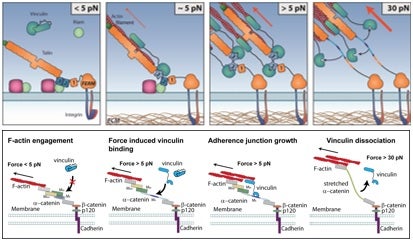Sensing mechanical forces by cells
YAN Jie (Group Leader, Physics ) () August 05, 201405 Aug 2014. NUS scientists have discovered how mechanical forces influence cell behavior.
How cells sense the mechanical properties of their environment and transform mechanical cues into cellular responses remain fully open questions. Now a research consortium of scientists from Singapore, France and UK has found that physiological levels of forces have drastic effects on key protein-protein interactions that regulate cell-extracellular matrix (ECM) and cell-cell adhesions. The ECM is a complex group of specialized proteins and provides structural support and attachment to the cells, which offers communication between cells and their surrounding environment and absorbs and transduces mechanical strains which is to be applied to tissues.
The research led by Professor YAN Jie at the Department of Physics and Mechanobiology Institute in NUS has shown direct evidence to a general mechanosensing mechanism in which proteins unfold as a result of cellular forces, exposing binding sites that trigger stable downstream signaling. Understanding of mechanosensing mechanisms will help scientists elucidate the pathology of the increasing number of diseases that are known to be related to misregulation of mechanosensing pathways. These include cancer, stroke and asthma. The shaping, maintenance and repair of tissues require fine tuning of cell adhesion and transmission of mechanical load from cell to its ECM and from one cell to another cell.

Image shows implications on regulations of cell-ECM and cell-cell adhesions through force-dependent binding of talin and a-catenin to vinculin. (Picture credit: YAN Jie)
References
1. M Yao, BT Goult, H Chen, P Cong, MP Sheetz, J Yan. “Mechanical activation of vinculin binding to talin locks talin in an unfolded conformation.” Scientific Reports 4 (2014) 4610.
2. M Yao, Wu Q, R Liu, AK Efremov, P Cong, R Seddiki, M Payre, Chwee TL, B Ladoux, RM Mège, J Yan. “Force-dependent conformational switch of α-catenin controls vinculin binding.” Nature Communications 5 (2014) 4525.
3. Ingber DE. “Mechanobiology and diseases of mechanotransduction.” Annals of Internal Medicine 35 (2003) 564.


